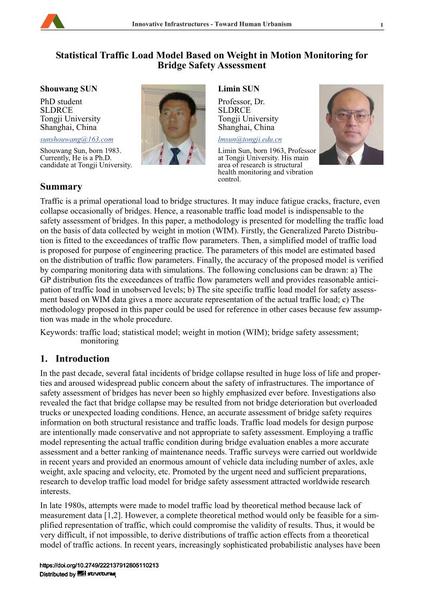Statistical Traffic Load Model Based on Weight in Motion Monitoring for Bridge Safety Assessment

|
|
|||||||||||
Détails bibliographiques
| Auteur(s): |
Shouwang Sun
Limin Sun |
||||
|---|---|---|---|---|---|
| Médium: | papier de conférence | ||||
| Langue(s): | anglais | ||||
| Conférence: | 18th IABSE Congress: Innovative Infrastructures – Towards Human Urbanism, Seoul, Korea, 19-21 September 2012 | ||||
| Publié dans: | IABSE Congress Seoul 2012 | ||||
|
|||||
| Page(s): | 60-67 | ||||
| Nombre total de pages (du PDF): | 8 | ||||
| DOI: | 10.2749/222137912805110213 | ||||
| Abstrait: |
Traffic is a primal operational load to bridge structures. It may induce fatigue cracks, fracture, even collapse occasionally of bridges. Hence, a reasonable traffic load model is indispensable to the safety assessment of bridges. In this paper, a methodology is presented for modelling the traffic load on the basis of data collected by weight in motion (WIM). Firstly, the Generalized Pareto Distribu- tion is fitted to the exceedances of traffic flow parameters. Then, a simplified model of traffic load is proposed for purpose of engineering practice. The parameters of this model are estimated based on the distribution of traffic flow parameters. Finally, the accuracy of the proposed model is verified by comparing monitoring data with simulations. The following conclusions can be drawn: a) The GP distribution fits the exceedances of traffic flow parameters well and provides reasonable antici- pation of traffic load in unobserved levels; b) The site specific traffic load model for safety assess- ment based on WIM data gives a more accurate representation of the actual traffic load; c) The methodology proposed in this paper could be used for reference in other cases because few assump- tion was made in the whole procedure. |
||||
| Mots-clé: |
modèle statistique
|
||||
